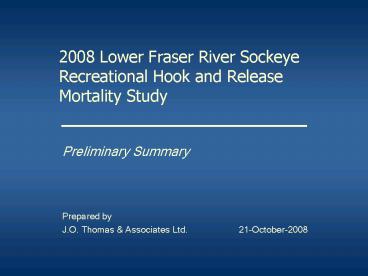Prepared by - PowerPoint PPT Presentation
1 / 25
Title:
Prepared by
Description:
Hooking Locations & Fish Condition. Typical sockeye hooking location in left ... of the study to assess physiological condition at time of capture or release. ... – PowerPoint PPT presentation
Number of Views:30
Avg rating:3.0/5.0
Title: Prepared by
1
2008 Lower Fraser River Sockeye Recreational Hook
and Release Mortality Study
Preliminary Summary
- Prepared by
- J.O. Thomas Associates Ltd.
21-October-2008
2
Background
- There are no mortality studies for sockeye caught
and released in freshwater using recreational
gear. - In recent years, the Department has been using a
10 mortality rate to sockeye released in
freshwater. - Due to the nature of bottom bouncing, the
majority of sockeye caught with this method are
primarily hooked on the outside of the mouth or
head. The location and degree of hooking
injuries suggests that mortality rates should be
low, but it needs to be quantified.
3
Introduction
- In 2007, the Cheam Band submitted a proposal to
the Fraser Salmon Watershed Program (FSWP) to
conduct a recreational hook and release sockeye
mortality study. The study was not conducted. - In 2008, the FSWP lead the development of a
comprehensive study design to estimate short-term
release mortality on sockeye caught and released
in the lower Fraser River recreational fishery. - The study design team worked with First Nations,
recreational anglers, consultants and
Departmental employees to ensure agreement on
study design, goals and implementation.
4
Study Design Team
- Project Biologist Jim Thomas of J.O Thomas
Associates - FRAFS, Pete Nicklin
- FSWP, Andrew Stegemann
- DFO Stock Assessment, Sue Grant, Richard Bailey,
Jason Mahoney, and Joe Tadey - DFO Resource Management, Debra Sneddon
- DFO Science, David Patterson
5
Objectives
- The primary objective of the study was to
estimate the short-term (24 hour) mortality of
hooked sockeye in a recreational catch release
fishery that commonly occurs in the Fraser River. - A secondary objective was to assess the influence
of selected variables like hooking location, hook
size, leader length, etc. on hooking mortality
rates.
6
Methodology
- Sockeye were caught by anglers using a range of
gear and angler experience. - Handling methods were representative of catch and
release practices common during in-river sockeye
recreational fisheries. - A control group of sockeye was included in the
study to estimate the mortality associated with
handling, fish transport, and holding in net pens
separately from hooking mortality.
7
Study Location
8
Results
Angling and Control Group Catch and Effort
- Angling effort ranged from 5 to 24 anglers per
day. The average daily number was 10. - Approximately 203 sockeye were hooked and 173
sockeye were landed by anglers over the 14 day
study period from Aug 5 to Sep 2. - A total of 103 sockeye control group sockeye were
captured by beach seine and held for observation
over four separate days.
9
Shore-based volunteer anglers fishing at Grassy
Bar
10
Retrieving a hooked sockeye
11
Beach seining for control group sockeye
12
Results contd
Angling Variables
- Leader lengths ranged from 8 to 16 feet. 77 of
the leader lengths were between 10 and 12 feet. - Hook sizes used in the fishery varied from size 1
to 4/0. 77 of hooks used were 3/0. - 98 of the angled sockeye in the study were
hooked by shore-based anglers and 2 were from
anglers in boats.
13
Typical bottom bouncing gear
14
Results contd
Hooking Locations Fish Condition
- 88 of the sockeye landed were hooked on the
outside of the mouth or body and 12 were hooked
on the inside of the mouth. - 75 of the sockeye hooked on the outside of the
mouth or body, were hooked in the maxillary bone
(and usually on the left side). - 98 of the hooked sockeye were vigorous at time
of landing. 82 showed no signs of bleeding 12
had light, and 6 had moderate bleeding.
15
Typical sockeye hooking location in left
maxillary
16
Assembling the net pen used for holding sockeye
17
Net pens with predator net enclosure
18
Transferring a sockeye to the net pen after
tagging
19
Results contd
Release Condition
- 98 of the hooked sockeye held for 24 hours were
released in a vigorous and not bleeding
condition. 1 of the hooked sockeye (2 fish)
were lethargic and not bleeding when released. - No control fish died during the study, suggesting
that handling, transferring, and holding were
negligible factors in overall mortality.
20
Releasing a live sockeye after holding for 24
hours
21
Results contd
Mortality Estimates
- Of the 173 sockeye hooked, only two died after
the 24 hour holding period, representing a
delayed hooking mortality rate of 1.2. - Necropsies on the two dead fish revealed that
only one of the mortalities could be directly
attributed to a hooking injury that occurred on
the ventral surface and mortally damaged vital
internal organs. - The other sockeye that died had a concurrent and
severe seal bite to the dorsal surface that was
believed to be the primary cause of death.
22
Results contd
Physiological Sampling
- Samples of blood and tissue were taken from about
20 of the sockeye over the course of the study
to assess physiological condition at time of
capture or release. - Samples were taken from both the control and the
angled groups. - This data will yield information on stress
response, muscle exertion, disease,
osmoregulation, fat levels, and DNA.
23
Physiological sampling team
24
Results contd
Environmental Sampling
- Periodic stream flow velocity measurements and
air and water temperatures were taken throughout
the study period. - Continuous in-river water temperatures were
collected at the both the angling site and the
net pen site.
25
Water temperature profiles at the angling site
and at the net pen site































